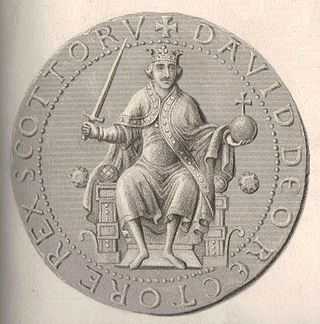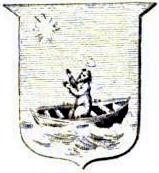Thurstan or Turstin of Bayeux was a medieval Archbishop of York, the son of a priest. He served kings William II and Henry I of England before his election to the see of York in 1114. Once elected, his consecration was delayed for five years while he fought attempts by the Archbishop of Canterbury to assert primacy over York. Eventually, he was consecrated by the pope instead and allowed to return to England. While archbishop, he secured two new suffragan bishops for his province. When Henry I died, Thurstan supported Henry's nephew Stephen of Blois as king. Thurstan also defended the northern part of England from invasion by the Scots, taking a leading part in organising the English forces at the Battle of the Standard (1138). Shortly before his death, Thurstan resigned from his see and took the habit of a Cluniac monk.
The Bishop of Galloway, also called the Bishop of Whithorn, is the ecclesiastical head of the Diocese of Galloway, said to have been founded by Saint Ninian in the mid-5th century. The subsequent Anglo-Saxon bishopric was founded in the late 7th century or early 8th century, and the first known bishop was one Pehthelm, "shield of the Picts". According to Anglo-Saxon ecclesiastical tradition, the bishopric was founded by Saint Ninian, a later corruption of the British name Uinniau or Irish Finian; although there is no contemporary evidence, it is quite likely that there had been a British or Hiberno-British bishopric before the Anglo-Saxon takeover. After Heathored, no bishop is known until the apparent resurrection of the diocese in the reign of King Fergus of Galloway. The bishops remained, uniquely for Scottish bishops, the suffragans of the Archbishop of York until 1359 when the pope released the bishopric from requiring metropolitan assent. James I formalised the admission of the diocese into the Scottish church on 26 August 1430 and just as all Scottish sees, Whithorn was to be accountable directly to the pope. The diocese was placed under the metropolitan jurisdiction of St Andrews on 17 August 1472 and then moved to the province of Glasgow on 9 January 1492. The diocese disappeared during the Scottish Reformation, but was recreated by the Catholic Church in 1878 with its cathedra at Dumfries, although it is now based at Ayr.
Wimund was a bishop who became a seafaring warlord adventurer in the years after 1147. His story is passed down to us by 12th-century English historian William of Newburgh in his Historia rerum anglicarum, Book I, Chapter 24 entitled "Of bishop Wimund, his life unbecoming a bishop, and how he was deprived of his sight".

The lords of Galloway consisted of a dynasty of heirs who were lords and ladies who ruled over Galloway in southwest Scotland, mainly during the High Middle Ages. Many regions of Scotland, including Galloway and Moray, periodically had kings or subkings, similar to those in Ireland during the Middle Ages. The Scottish monarch was seen as being similar to a high king. The lords of Galloway would have either paid tribute to the Scottish monarch, or at other times ignored him. The Lords of Galloway are fairly well recorded in the 12th and 13th centuries, but the records are incomplete or conflicting at other times. Later on, the kings were known as "lords" at the Scottish court, and "kings" at home, finally becoming "lords" in both arenas.

Fergus of Galloway was a twelfth-century Lord of Galloway. Although his familial origins are unknown, it is possible that he was of Norse-Gaelic ancestry. Fergus first appears on record in 1136, when he witnessed a charter of David I, King of Scotland. There is considerable evidence indicating that Fergus was married to an illegitimate daughter of Henry I, King of England. It is possible that Elizabeth Fitzroy was the mother of Fergus's three children.

Dundrennan Abbey, in Dundrennan, Scotland, near to Kirkcudbright, was a Cistercian monastery in the Romanesque architectural style, established in 1142 by Fergus of Galloway, King David I of Scotland (1124–53), and monks from Rievaulx Abbey. Though extensively ruined, Dundrennan is noted for the purity and restraint of its architecture, reflecting the austere Cistercian ideal. It is also built from very hard-weathering grey sandstone, so the original architectural forms and mouldings are well preserved.
Gille Brigte or Gilla Brigte mac Fergusa of Galloway, also known as Gillebrigte, Gille Brighde, Gilbridge, Gilbride, etc., and most famously known in French sources as Gilbert, was Lord of Galloway of Scotland. Gilla Brigte was one of two sons of the great Fergus, the builder of the "Kingdom" of Galloway.

Donnchadh was a Gall-Gaidhil prince and Scottish magnate in what is now south-western Scotland, whose career stretched from the last quarter of the 12th century until his death in 1250. His father, Gille-Brighde of Galloway, and his uncle, Uhtred of Galloway, were the two rival sons of Fergus, Prince or Lord of Galloway. As a result of Gille-Brighde's conflict with Uhtred and the Scottish monarch William the Lion, Donnchadh became a hostage of King Henry II of England. He probably remained in England for almost a decade before returning north on the death of his father. Although denied succession to all the lands of Galloway, he was granted lordship over Carrick in the north.
Galwegian Gaelic is an extinct dialect of Scottish Gaelic formerly spoken in southwest Scotland. It was spoken by the people of Galloway and Carrick until the early modern period. Little has survived of the dialect, so that its exact relationship with other Gaelic language is uncertain.
Christian of Whithorn was Bishop of Whithorn (1154–1186), the second incumbent of that Episcopal See since it had been resurrected by King Fergus of Galloway earlier in the 12th century.

Guillaume or William de Malveisin was Chancellor of Scotland, Bishop of Glasgow (1199/1200–1202) and then Bishop of St. Andrews (1202–1238).
Óláfr Guðrøðarson was a twelfth-century King of Mann and the Isles. As a younger son of Guðrøðr Crovan, King of Dublin and the Isles, Óláfr witnessed a vicious power struggle between his elder brothers in the aftermath of their father's death. At some point, the young Óláfr was entrusted to the care of Henry I, King of England, and like the contemporaneous Scottish monarchs, Alexander I and David I, Óláfr appears to have been a protégé of the English king. As King of the Isles, Óláfr contracted marital alliances with neighbouring maritime rulers. Although he appears to have overseen successful military operations to reclaim the northernmost territories once controlled by his father, he may have witnessed the loss of authority in Galloway as well. Like his counterpart David I, Óláfr was a reformer and moderniser of his realm. However, his four-decade reign ended in abrupt disaster when he was assassinated by three nephews in 1153. Following the ensuing power struggle, Óláfr's son Guðrøðr overcame the kin-slayers, and assumed the kingship of the Kingdom of the Isles.
John was an early 12th-century Tironensian cleric. He was the chaplain and close confidant of King David I of Scotland, before becoming Bishop of Glasgow and founder of Glasgow Cathedral. He was one of the most significant religious reformers in the history of Scotland. His later nickname, "Achaius", a latinisation of Eochaid would indicate that he was Gaelic, but the name is probably not authentic. He was in fact a Tironensian monk, of probable French origin.

The Davidian Revolution is a name given by many scholars to the changes which took place in the Kingdom of Scotland during the reign of David I (1124–1153). These included his foundation of burghs, implementation of the ideals of Gregorian Reform, foundation of monasteries, Normanisation of the Scottish government, and the introduction of feudalism through immigrant Norman and Anglo-Norman knights.

Historical treatment of David I and the Scottish church usually emphasises King David I of Scotland's pioneering role as the instrument of diocesan reorganisation and Norman penetration, beginning with the bishopric of Glasgow while David was Prince of the Cumbrians, and continuing further north after David acceded to the throne of Scotland. As well as this and his monastic patronage, focus too is usually given to his role as the defender of the Scottish church's independence from claims of overlordship by the Archbishop of York and the Archbishop of Canterbury.
John of Whithorn was the medieval Bishop of Galloway. His first appearance as bishop-elect is at the coronation of Richard, Cœur de Lion as King of the English at Westminster Abbey on 3 September 1189. He was consecrated at Pipewell Abbey, Northamptonshire, on Sunday 17 September 1189.

Gilbert was a 13th-century Cistercian monk, abbot and bishop. His first appearance in the sources occurs under the year 1233, for which year the Chronicle of Melrose reported that "Sir Gilbert, the abbot of Glenluce, resigned his office, in the chapter of Melrose; and there he made his profession". It is not clear why Gilbert really did resign the position of Abbot of Glenluce, head of Glenluce Abbey in Galloway, in order to become a mere brother at Melrose Abbey; nor is it clear for how long Gilbert had been abbot, though his latest known predecessor is attested last on 27 May 1222. After going to there, Gilbert became the Master of the Novices at Melrose.
Odo Ydonc was a 13th-century Premonstratensian prelate. The first recorded appearance of Odo was when he witnessed a charter by Donnchadh, Earl of Carrick, on 21 July 1225. In this document he is already Abbot of Dercongal, incidentally the first Abbot of Dercongal to appear on record.
Heathored of Whithorn is sometimes given as the Northumbrian Bishop of Whithorn, following the demise of Bishop Beadwulf. He is possibly the last known Anglo-Saxon Bishop of Whithorn. His name occurs for the last time around 833; no other bishop at Whithorn is known until the accession around three centuries later of Gille Aldan. It is sometimes thought that he may be the same man as Bishop Heathored of Lindisfarne.

The Diocese of the Isles, also known as the Diocese of Suðreyar, or the Diocese of Sodor, was one of the dioceses of medieval Norway. After the mid-13th-century Treaty of Perth, the diocese was accounted as one of the 13 dioceses of Scotland. The original seat of the bishopric appears to have been at Peel, on St Patrick's Isle, where indeed it continued to be under English overlordship; the Bishopric of the Isles as it was after the split was relocated to the north, firstly to Snizort and then Iona.







